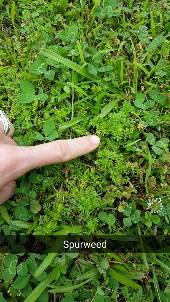Weed of the Week
Nashville, Ark. – Lawn Burweed, also known as “spurweed” or “the tiny stickers in my yard” is common to the southern half of Arkansas. Yes, this is the tiny sticker that hurts like no-other when you or your pet steps on it. No, there are no stickers in your yard right now. However, spurweed is a winter annual weed that germinates in the fall/winter, blooms in late winter to early spring and sets the seed (that nasty sticker) later in spring.
So what does that mean? Now is the time to spray for it! Spray now through February to kill the weeds before they set seeds. The best herbicide to use is a post-emergent herbicide containing 2,4-D. There are different brand names, percentage formulations and numerous formulations of two or three way mixes of herbicides containing dicamba or MCPP. Make sure to read the label before application to make sure the specific formulation and percentage of chemical that you choose is appropriate for your lawn or pasture. For instance, Bermuda grass tends to be more herbicide tolerant than St. Augustine or Centipede. Lastly, make sure to always read the label and follow mixing and sprayer instructions; this is key to insure effective control of spurweed.
So how do you know if you have spurweed? Here is what to look for. They are tiny plants. They germinate in the fall, producing a ground-hugging plant with parsley-like leaves. In late winter, the blooms will be tiny white flowers. The leaves are also “lacy” and fruit is inset in the plant. Right now, the fruit or sticker is not going to pierce the skin or feel like it does when it hurts later in the summer.
All this information was obtained from Extension resources. If you are interested in more detailed information regarding spurweed or other nuisance plants, we have various fact sheets and MP’s for weed control in Arkansas.
By Kaycee Davis
County Extension Agent - Agriculture
The Cooperative Extension Service
U of A System Division of Agriculture
Media Contact: Kaycee Davis
County Extension Agent - Agriculture
U of A Division of Agriculture
Cooperative Extension Service
421 N. Main Nashville AR 71852
(870) 845-7517
kmdavis@uada.edu
Related Links
The Arkansas Cooperative Extension Service is an equal opportunity institution.
If you require a reasonable accommodation to participate or need materials in another
format, please contact your County Extension office (or other appropriate office)
as soon as possible. Dial 711 for Arkansas Relay.
Pursuant to 7 CFR § 15.3, the University of Arkansas System Division of Agriculture
offers all its Extension and Research programs and services (including employment)
without regard to race, color, sex, national origin, religion, age, disability, marital
or veteran status, genetic information, sexual preference, pregnancy or any other
legally protected status, and is an equal opportunity institution.
